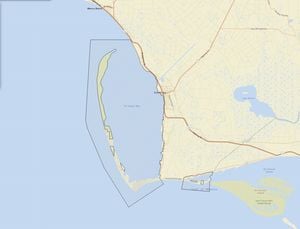One fact about some of Gulf County’s most popular beaches of Cape San Blas and Indian Pass are that they reside in a CBRA zone (we pronounce it as “cobra” in general conversation). It’s not real important for families vacationing for the week who just simply want to enjoy the pristine waters and relaxed atmosphere, but we get many questions that arise when new potential buyers learn about this designation and how it might impact their potential property investment. We’re always happy to help answer your questions, and in this guide we will go into further detail.
The Coastal Barrier Resources Act (CBRA) was enacted by the United States Congress in 1982 to minimize the loss of life and property in coastal floodplains, reduce wasteful expenditures of federal revenues, and protect the natural resources associated with coastal barrier systems. CBRA establishes the Coastal Barrier Resources System (CBRS), which consists of undeveloped coastal barriers and other areas along the Atlantic and Gulf Coasts of the United States.
In Florida, the CBRA zones encompass certain coastal barrier islands and associated areas that are designated as part of the Coastal Barrier Resources System. These areas are identified as CBRA zones on maps maintained by the U.S. Fish and Wildlife Service (USFWS). The purpose of designating these areas as CBRA zones is to discourage development in high-risk coastal areas that are vulnerable to erosion, storm surge, and other natural hazards.
Properties located within CBRA zones may face restrictions or limitations on federal financial assistance, including federally backed flood insurance and certain types of federal grants or loans for development or construction. These restrictions are intended to discourage development in environmentally sensitive coastal areas and reduce the potential for loss of life and property due to coastal hazards.
It’s important for property owners and developers in Florida to be aware of CBRA zones and the associated regulations when planning construction or development projects in coastal areas. Compliance with CBRA regulations can help minimize risks associated with coastal hazards and protect natural resources in vulnerable coastal environments.

Pictured above is a map showing the CBRA zone areas for Cape San Blas and Indian Pass (shown within the lined areas)
Cape San Blas and Indian Pass, located on the Gulf Coast of Florida, are a few of the areas that fall within the Coastal Barrier Resources System (CBRS) established by the Coastal Barrier Resources Act (CBRA). As a result, properties within the majority of Cape San Blas and Indian Pass are subject to the regulations and restrictions imposed by the CBRA zone designation.
When it comes to home construction in Cape San Blas, the CBRA zone designation can have several implications:
- Limited Federal Assistance: Properties within CBRA zones, including Cape San Blas, may have limited access to federal financial assistance for home construction and development. This limitation includes federally backed flood insurance, which may not be available for new construction or substantial improvements to existing structures within CBRA zones.
- No New Infrastructure: The CBRA prohibits federal funding for the construction of new infrastructure within designated CBRA zones. This restriction may impact the availability of public utilities and services for new homes built in Cape San Blas, as federal funds cannot be used to support the development of infrastructure in these areas.
- Private Insurance Requirements: Since federal flood insurance may not be available for properties within CBRA zones, homeowners in Cape San Blas may need to rely on private insurance options to protect their properties against flood damage. Private insurers may offer flood insurance coverage for properties in CBRA zones, although premiums and coverage terms may vary.
- Environmental Considerations: The CBRA aims to protect environmentally sensitive coastal areas, including barrier structures like Cape San Blas and Indian Pass, from development that could harm natural resources and ecosystems. As such, homeowners and developers on Cape San Blas and Indian Pass must adhere to environmental regulations and considerations when planning construction projects to minimize their impact on the local environment.
Frequently asked questions regarding the CBRA zone:
- “How common are CBRA zones in Florida?” CBRA zones are relatively common in Florida, especially along the state’s extensive coastline. Florida has numerous barrier islands, coastal marshes, and other coastal features that meet the criteria for inclusion in the Coastal Barrier Resources System (CBRS) established by the Coastal Barrier Resources Act (CBRA) of 1982.
Overall, the CBRA zone designation affects home construction by limiting access to federal assistance, restricting new infrastructure development, and emphasizing environmental conservation. Homeowners and developers should be aware of these implications and ensure compliance with CBRA regulations when planning and undertaking construction projects in the area. To preview the map, visit the Gulf GIS mapping website here (be sure to click on Map Layers>Building & Planning>COBRA): https://maps2.roktech.net/GulfGoMaps4/?mapName=GIS#
The information herein is deemed reliable but not guaranteed. State and local ordinances subject to change. Please confirm all information before purchasing or permitting to build.

